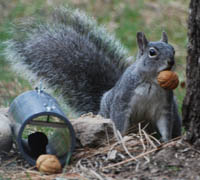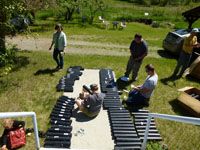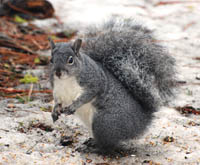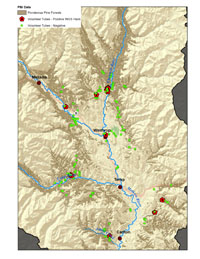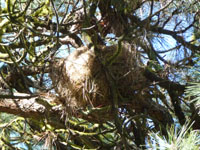Citizen Science Volunteer Resources
for the Western Gray Squirrel Project
This page has updates for citizen science volunteers working on the western gray squirrel project.
Pacific Biodiversity Institute is grateful for all of the help from our many dedicated volunteers (see the right sidebar).
2015 Project objectives
This field season, staff and volunteers will be contributing to a three-year, state-wide survey in partnership with Washington Department of Fish and Wildlife (WDFW). This extensive, rigorous study will survey all of Washington State, putting PBI's Methow Valley work into context. Our section of the study will be a piece in the larger puzzle of determining where this elusive animal lives.
We will also be surveying areas affected by the Carlton Complex Fire. Though we've had some early positive signs, we aren't certain how squirrels will react to the burned habitat. Comparisons with our previous surveys will give us better information about fire effects on squirrels in the Methow.
2014 Project objectives
The initial focus of the 2014 field season was to further explore the established squirrel population near the lower Chewuch River. Volunteers and this year’s intern, Katrina Fisk, placed over 140 tubes in this area. However, after the Carlton Complex wildfire which covered over 256,000 acres of land in the Methow Valley, more than 30 hair tubes and 6 camera locations were set in the burned area to determine effects on wildlife.
2013 Project objectives
A total of 110 hair tubes were placed by volunteers and the 2013 intern, Debbie Lewis. Out of these, 15 had positive western gray squirrel hair samples from 8 different locations. These locations confirmed previous positive results in the area, as well as filling in the area between previous year's positive samples.
2012 Project objectives
In 2012, volunteers worked to get more extensive coverage across the Methow Valley. Beginning in July, a dozen volunteers placed tubes from French Creek to Early Winters, near the Chewuch River, Twisp River and a number of tributaries. Our 2012 intern was Patricia Thomas, who placed over 100 sampling tubes.
2011 Experiment to find the optimum tube size
Intern Hannah Edwards worked on an experiment to compare different lengths and widths of sampling tubes. We suspected that longer tubes may hamper access to the bait, stimulating squirrels to gnaw the tubes. Initial results from several experimental set-ups seem to bear this out, but they haven't answered the converse question, which is that if long tubes don't perform as well, do shorter tubes perform better?
In this experiment, we also set up a remote camera at one of the tube stations. What we got was nothing short of amazing.
Check out our other western gray squirrel videos here!
Downloadable Forms
 Travel voucher reimbursement forms.
Travel voucher reimbursement forms.
 Gray squirrel survey protocol.
Gray squirrel survey protocol.
 Gray squirrel hair tube survey data sheet.
Gray squirrel hair tube survey data sheet.
 Gray squirrel hair tube survey data sheet for burned area.
Gray squirrel hair tube survey data sheet for burned area.
 Gray squirrel observation form.
Gray squirrel observation form.
 Gray squirrel nest observation form.
Gray squirrel nest observation form.
Copyright © 2009 Pacific Biodiversity Institute
PO Box 298, 517 Lufkin Lane
Winthrop, WA 98862 509-996-2490
